Keio University (慶應義塾大学, Keiō Gijuku Daigaku), abbreviated as Keio (慶應) or Keidai (慶大), is a private research university located in Minato, Tokyo, Japan.
慶應義塾大学 | |
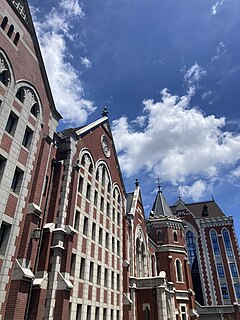 | |
| Motto | Latin: Calamus gladio fortior |
|---|---|
Motto in English | The pen is mightier than the sword[1] |
| Type | Private research coeducational higher education institution |
| Established | 1858 (as a school for Dutch studies) 1920 (as a university)[2] |
| Founder | Fukuzawa Yukichi |
Academic affiliations | ASAIHL, CoBS, CEMS – The Global Alliance in Management Education |
| Endowment | 706M US$ |
| President | Kohei Itoh |
Academic staff | full time 2,791 (As of May 1, 2022)[3] |
Administrative staff | full-time 3,252 (As of May 1, 2022)[4] |
| Students | 33,437 (As of May 1, 2022)[5][needs update] |
| Undergraduates | 28,641 (As of May 1, 2022)[5][needs update] |
| Postgraduates | 4,796 (As of May 1, 2022)[5][needs update] |
| 1,426[5][note 1][needs update] | |
Other students | 0[note 2][needs update] |
| Location | , Tokyo , Japan |
| Campus | Urban |
| Flag |  |
| Colors | Yellow, blue, and red |
| Nickname | Unicorns, etc. |
| Athletics | 39 varsity teams |
| Website | keio.ac.jp |
It is the oldest institute of western higher education in Japan. Its founder, Fukuzawa Yukichi, originally established it as a school for Western studies in 1858 in Edo. It was granted university status in 1920, becoming one of the first private universities in the country.
The university is one of the members of the Top Global University Project (Top Type), funded by the Japanese Ministry of Education, Culture, Sports, Science and Technology.[6] Keio University is also one of the member universities of RU11[7] and APRU, and it is one of only two Japanese universities (alongside the University of Tokyo) to be a member of the World Economic Forum's Global University Leaders Forum.[8]
Its list of alumni and faculty includes three former prime ministers,[9] two astronauts,[9] six international honorary members of the American Academy of Arts and Sciences, and a Wolf Prize winner. Keio University also produced the largest number of CEOs of companies listed in the first section of Tokyo Stock Exchange.[9][10]
Overview


Keio traces its history to 1858 when Fukuzawa Yukichi, who had studied the Western educational system at Brown University in the United States, started to teach Dutch while he was a guest of the Okudaira family. In 1868 he changed the name of the school to Keio Gijuku and devoted all his time to education. While Keio's initial identity was that of a private school of Western studies, it expanded and established its first university faculty in 1890, and became known as a leading institute in Japanese higher education. It was the first Japanese university to reach its 150th anniversary, celebrating this anniversary in 2008.
Keio has leading research centres. It has approximately 30 Research Centers located on its five main campuses and at other facilities for advanced research in Japan.[11] Keio University Research Institute at SFC (KRIS) has joined the MIT and the French INRIA in hosting the international W3C.[12]
Mission
In his speech at an alumni gathering on November 1, 1896, Fukuzawa stated the mission of Keio as follows:
Keio Gijuku shouldn't be satisfied with being just one educational institution.
Its mission is expected to be a model of the nobility of intelligence and virtue,
to make clear how it can be applied to its family, society, and nation,
and to take an actual action of this statement.
It expects all students to be leaders in society by the practice of this mission.
Those sentences were given to students as his will and considered as the simple expression of Keio's actual mission.[13]
Academic culture
Keio is known for being the first institution to introduce many modern education practices in Japan.
Keio is the earliest Japanese school that introduced an annual fixed course fee, designed by Fukuzawa.[note 3]It initially introduced the culture of speech to Japan, which Japan had never had before. It built Japan's earliest speech house Mita Speech House in 1875 as well.[14]Keio is regarded as Japan's first university to accept international students.[15] Keio accepted 2 Korean students in 1881 as its (and also Japan's) first international students. 60 Korean students entered in 1883 and 130 Korean students in 1895.
Keio put "Independence and self-respect (独立自尊, Dokuritsu Jison)" as a foundation of its education. This is meant to be physically and mentally independent, and respect yourself for keeping your virtue.[16] Independence and self-respect are also regarded as Fukuzawa's nature and essence of his education.[17]
Learning half and teaching half (半学半教, Hangaku Hankyo) is the other unique culture at Keio.[18] During the late Edo period and the early Meiji period, several private prep schools often used students as assistant teachers and it was called "Learning half and teaching half". Keio also had initially used this system. In the early period of such schools of Western studies, there had been many things to learn not only for students but also professors themselves. Hence there had been occasions when students who had learned in advance had taught other students and even professors. After the proper legal systems for education had been set up, those situations disappeared. However, Fukuzawa thought the essence of academia was and is a continuous learning process, and that more knowledge provided more learning opportunities. Keio respects his thought and established the rule "Rules in Keio Gijuku (慶應義塾社中之約束, Keio Gijuku Shachu no Yakusoku)", which states that there shouldn't be any hierarchy between teachers and learners and that all of the people in Keio Gijuku are in the same company. For this reason, there is still a culture at Keio that all professors and lecturers are officially called with the honorific of "Kun" but never "Teacher" or "Professor".[19][20]
Collaboration in a company (社中の協力, Shachu no Kyoryoku) is also a uniqueness of Keio.[21] Fukuzawa stated in 1879 that the Keio's success today is because of the collaboration in its company, and "Collaboration in a company" originally came from this article. People in Keio often think that all of the people related to Keio (e.g. professors, students, alumni and their family members) are part of their company, thus they should try to help each other like brothers and sisters. This culture has been often seen especially in the alumni organization called Mita-Kai.[22]
History
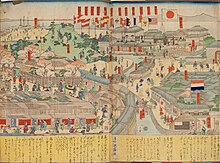

Keio University (慶應義塾大学, Keiō Gijuku Daigaku) was established in 1858 as a School of Western studies located in one of the mansion houses in Tsukiji by the founder Fukuzawa Yukichi.[23] Its root is considered as the Han school for Kokugaku studies named Shinshu Kan established in 1796.[24] Keio changed its name to "Keio Gijuku" in 1868, which came from the era name "Keio"[25] and "Gijuku" as the translation of Private school.[26] It moved to the current location in 1871, established the Medical school in 1873, and the official university department with Economics, Law and Literacy study in 1890.[27]
| Year | University Development |
|---|---|
| 1858 | Establishment of Keio Gijuku |
| 1879 | Keio rejected an offer to become a national university.[28] Instead of that, it became a vocational school funded by daimyōs including Shimazu clan. |
| 1890 | Departments of Economics, Law, and Letters established |
| 1906 | Graduate studies programs established |
| 1917 | School of Medicine established |
| 1920 | Keio authorized as a university in the prewar system |
| 1944 | School of Technology established |
| 1949 | Keio authorized as a university in the post-war system |
| 1957 | School of Business and Commerce established |
| 1962 | Graduate School of Business Administration established |
| 1981 | Department of Science and Technology established |
| 1990 | School of Environmental and Information Studies and School of Policy Management established |
| 2001 | School of Nursing and Medical Care established |
| 2004 | School of Law established |
| 2008 | School of Pharmacy established |
| 2008 | Graduate School of Media Design established |
In 1886, Keio named Hiromoto Watanabe as the first chancellor of the Imperial University (University of Tokyo). He was the first chancellor of an officially authorized university in Japan. In 1899, Keio sent 6 students to study abroad. In the same year, it accepted three international students from India, Qing-dynasty China, and Thailand. Eight international students entered from Taiwan (which had technically been a territory of the Japanese Empire since 1895) in the following year. Keio was visited by Bengali poet Rabindranath Tagore in 1916. In 1922, Keio was visited by Albert Einstein, who presented a special lecture on the theory of relativity.[29] In 1946, Keio began accepting female students. In 2006, a paper with a Keio undergraduate student as its first listed author was published in the research journal Science.[30][31] In 2008, Keio was visited by Prince Charles.
Presidents
Since the president system was established in 1881, Keio has had 20 presidents.[32]
| President | Tenure | President | Tenure | President | Tenure | President | Tenure | ||||
|---|---|---|---|---|---|---|---|---|---|---|---|
| 1. | Sadashiro Hamano | 1881–1887 | 7. | Shinzo Koizumi | 1933–1947 | 13. | Saku Sato | 1969–1973 | 19. | Akira Haseyama | 2017–2021 |
| 2. | Nobukichi Koizumi | 1887–1890 | 8. | Seiichiro Takahashi | 1946–1947 | 14. | Hiroshi Kuno | 1973–1977 | 20. | Kohei Itoh | 2021– |
| 3. | Tokujiro Obata | 1890–1897 | 9. | Kouji Ushioda | 1947–1956 | 15. | Tadao Ishikawa | 1977–1993 | |||
| 4. | Eikichi Kamata | 1898–1922 | 10. | Fukutaro Okui | 1956–1960 | 16. | Yasuhiko Torii | 1993–2001 | |||
| 5. | Ichitaro Fukuzawa | 1922–1923 | 11. | Shohei Takamura | 1960–1965 | 17. | Yuichiro Anzai | 2001–2009 | |||
| 6. | Kiroku Hayashi | 1923–1933 | 12. | Kunio Nagasawa | 1965–1969 | 18. | Atsushi Seike | 2009–2017 |
Student body
In 2021, there are 33,469 students at Keio University, with 28,667 undergraduate students and 4,802 graduate students. Although two-thirds of the student body are males, this ratio highly depends on the major (56% of students are female in the Faculty of Letters, for instance. On the other hand, in the School of Medicine, three-quarters of students are men.).[5]
| Undergraduate | Graduate (Master) | Graduate (Doctor) | Professional | Total | |
|---|---|---|---|---|---|
| Total | 28,667 | 3,034 | 1,408 | 360 | 33,469 |
| Male | 18,346 | 2,044 | 985 | 228 | 21,603 |
| Female | 10,321 | 990 | 423 | 132 | 11,866 |
| International | 874 | 861 | 1,735 | ||
There are 1,908 international students on May 1, 2021, with 874 undergraduate students (3.1% of total undergraduate students (=28,667) ), 861 graduate students (18.0% of total graduate students (=4,802) ) and 173 other students.[33] China is the country which provides the most international students with 1,016, followed by South Korea (436), France (66), Taiwan (51), the United States (36), Indonesia (34), and Germany (29).[33]
Student life
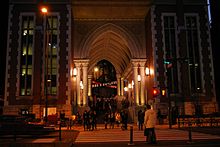
Societies
In Japanese universities, there are student societies called "circles". Although the exact number is not clear, there are over 410 circles in Keio.[34]
Festivals
Keio holds school festivals every year on each campus. The main festival is called "Mita Sai" and is usually held on the Mita campus in late November.[35] Mita Sai includes various academic and recreational activities and also serves as a research workshop for students on the Mita campus.[36] Approximately 200,000 people visit Mita Sai every year.[37]
Athletics
Edward Bramwell Clarke and Tanaka Ginnosuke first introduced Rugby union to Japanese students at Keio University. The game had been played in the treaty ports of Yokohama and Kobe before that, but not between Japanese teams.
The interest of Keio's students in baseball stretches back to the early years of the 20th century. In 1913, an American touring team of players from the New York Giants and the Chicago White Sox played an exhibition game against the Keio team.[38] In a 1932 exhibition game, the Keio team beat the University of Michigan team, which was then touring Japan.[39]Keio's baseball team plays in the Tokyo Big6 Baseball League (six prominent universities in the Tokyo area).
Association football
Keio University's association football (soccer) team is the most successful team in the history of the Emperor's Cup, although their last triumph was in 1956. They have won nine times, a number no professional team has ever achieved in the tournament.
Kei-So rivalry
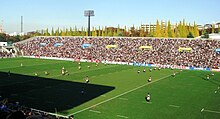
Traditionally, there has been a strong rivalry between Keio and Waseda University. There are annually many matches between the two universities in several sports, such as baseball, rowing, rugby, lacrosse, track and field, American football, association football, aikido, karate, basketball, tennis, swimming, fencing, figure skating, ice hockey, and field hockey. These games are called "Kei–So Sen (慶早戦)" or, more generally, "So–Kei Sen (早慶戦)".
The Kei-So baseball rivalry, which dates back more than a century, is especially famous because of its importance in Japanese baseball history. The most famous Kei-So baseball game, which was played on October 16, 1943, was made into a movie titled "The Last Game – the Final So-Kei Sen -" in 2008.
There are two Kei-So baseball games every year, and they are usually broadcast by NHK. There is no lecture on all campuses in Keio on the game day because of the students who want to watch this match. Kei-So baseball games were even visited by Japanese emperors in 1929, 1950 and 1994.
Keio University is one of the most prestigious universities in Japan. Times Higher Education estimates that Keio is in 351–400th place in general academic rankings among world universities.
American football
Scandals
In October 2016, six male students from Keio Advertisement Society, a long-standing student club famous for its organisation of the Miss Keio pageant contest, were investigated for gang rape during a club activity.[40] An out-of-court settlement was reached and the students were not prosecuted.[41] In May 2018, another three students were arrested for sexual assaults.[42]
In March 2017, a student tennis club was disbanded after a student died of alcohol poisoning during a club activity. Two other Keio students died due to over-drinking in 2012 and 2013.[43]
In June 2017, the school's election committee unconventionally selected Haseyama Akira, a legal history professor who only won second place at the general election among teachers and staff, to be the school's new president, breaking a 50-year convention.[44]
In late 2019, both the American football team and the cheerleading club suspended club activities for "inappropriate behaviours".[45][46]
In January 2020, it was reported that a former member of the school president's secretarial staff had installed a camera in a female toilet stall on the Mita campus, filming over a thousand videos over 3 months.[47][48]
Academic rankings
| THE National[49] | General | 12 | |
|---|---|---|---|
| T. Reuters National[50] | Research | 13 | |
| WE National[51] | Employment | 3 | |
| NBP Greater Tokyo[52][53] | Reputation | 3 | |
| Shimano National[54] | Selectivity | SA | |
| QS Asia (Asia version)[55] | General | 45 | |
| THE World[56] | General | 601–800 | |
| QS World[57] | General | 214 | |
| ARWU World[58] | Research | 301–400 | |
| ENSMP World[59] | Alumni | 3 | |
| Social Sciences & Humanities | |||
|---|---|---|---|
LAW | |||
| Asahi National[60] | Research | 2 | |
| Natural Sciences & Technology | |||
Engineering | |||
| QS World[61] | General | 179 | |
Keio ranks 53rd in the world in the Times Higher Education's Alma Mater Index.[66] It ranks 34th globally in the Center for World University Rankings (CWUR) and 3rd in Asia.[67] Keio is ranked at 58th of the Reuters Top 100 innovative universities worldwide.[68] British Quacquarelli Symonds (QS) company estimates that Keio is ranked the 192nd in QS World University Rankings 2017/18.[69] It is ranked the 45th in QS World University Ranking 2017/18 for Graduate Employability Ranking. In the Asian University Ranking (2015), Quacquarelli Symonds also ranked Keio as 37th in Asia.[69] The Academic Ranking of World Universities (2015), which is compiled by Shanghai Jiao Tong University, ranks Keio 151-175 in the world and 37 in Asia.[70] Keio, with Waseda University, is one of the prominent private universities within Japan. The difficulty level of entrance exams at Keio University is one of the highest among private universities in Japan.[71]
Research performance
According to Thomson Reuters, Keio is the 10th best research university in Japan, and it is the only private university within the Top 15.[50] In addition, Weekly Diamond reported that Keio has the 8th highest research standard in Japan in terms of research fundings per researchers in COE Program, and it is also the only private university within Top 10.[72] The Asahi Shimbun summarized the number of academic papers in Japanese major legal journals by the university, and Keio was ranked 2nd during 2005–2009.[60] Accordingly, Keio is a prominent research university in Japan.
In economics, according to The Asahi Shimbun, Keio's been ranked 7th in Japan in the economic research ranking during 2005–2009.[73] More recently, Repec in January 2011 ranked Keio's Economic department as Japan's 6th best economic research university.[74] Keio has provided 3 presidents of Japanese Economic Association in its 42-year history, and this number is 5th largest.[75]
In addition, Nikkei Shimbun on 2004/2/16 surveyed about the research standards in Engineering studies based on Thomson Reuters, Grants in Aid for Scientific Research and questionnaires to heads of 93 leading Japanese Research Centers, and Keio was placed 8th (research planning ability 4th/informative ability of research outcome 3rd) in this ranking.[76]
Business
Keio ranks second in Japan, for the number of alumni holding CEO positions in Fortune Global 500 companies, according to Mines ParisTech: Professional Ranking of World Universities.[59] Keio is also ranked 1st in Japan for the number of alumni generally holding executive positions (when positions like COO, CFO, CIO etc. are included along with the CEO position) in listed companies of Japan, and this number per student (probability of becoming an executive) is also top.[77][78]
Keio Business School is Japan's first business school and one of four Japanese schools holding The Association to Advance Collegiate Schools of Business (AACSB) accreditation.[79] Keio was ranked No. 1 in Japan by Nikkei Shimbun.[80] Eduniversal also ranked Keio as the top in Japan (75th in the world).[81] In Eduniversal Keio is one of only 3 Japanese schools categorized in "Universal Business schools with major international influence". In 2012, the Keio Business School became a founding member of the university alliance Council on Business & Society that consists of Tuck School of Business from the USA, the University of Mannheim Business School from Germany, ESSEC Business School from France, Fudan University from China, Fundação Getúlio Vargas from Brazil and Keio Business School.
According to the Weekly Economist's 2010 rankings and the PRESIDENT's article on 16 October 2006, graduates from Keio University have the 3rd best employment rate in 400 major companies, and the alumni's average salary is the 3rd best in Japan.[82][83]
Accounting
As an extension of Keio's strong business focus, for over 30 years, Keio graduates have been ranked first in Japan in the number of successful national CPA exam applicants.[11]
Medicine
Keio has been influential in Japanese medical societies as well. In fact, there have been 4 presidents of Japan Medical Association related to this university (2 Alumni and 2 professors).[note 4] This number is the 2nd largest among Japanese medical schools.[84] Keio is one of 2 Japanese universities which provided a president of World Medical Association.[85]
Law
Keio's law faculty is typically ranked among the best in all of Japan along with the University of Tokyo, University of Kyoto, Chuo University, and Hitotsubashi University. In 2010 and 2015, Keio University Law School ranked highest among all Japanese universities for the Bar Exam passage rate.[86] Furthermore, the number of Members of Parliament who graduated Keio has been 3rd in Japan.[73][87]
Popularity and selectivity
Keio is a popular university in Japan, often considered one of Japan's top two private universities alongside their rival, Waseda University. The number of applicants per place was 11.7 (48260/4098) in 2011 undergraduate admissions.[88] Its entrance difficulty is usually considered as the top with Waseda among 730 private universities.[note 5][note 6][note 7]
Nikkei BP has been publishing a ranking system called "Brand rankings of Japanese universities" every year, composed of the various indications related to the power of the brand, in which Keio was the top in 2014, and ranked second in 2015 and 2016 in Greater Tokyo Area.[89] Webometrics (2008) also ranks Keio University as 3rd in Japan, 11th in Asia, and 208th in the world for quantity and quality of web presence and link visibility.[90]
In a unique ranking, TBS ranked Japanese universities by the questionnaire "Which university student do you want to have as your boyfriend?" to 300 girls in Shibuya, and Keio was ranked 1st in this ranking.[note 8]
Evaluation from Business World
| Ranking | |
|---|---|
| all universities in Japan | 3rd[91] out of all the 744[92] universities which existed as of 2006 |
| Source | 2006 Survey[91] by Weekly Diamond 〈ja〉 on the ranking of the universities which produced the high ratio of the graduates who hold the position of "president and chief executive officer of listed company" to all the graduates of each university |
| Ranking | |
|---|---|
| all universities in Japan | 26th[93] out of all the 778[94] universities which existed as of 2010 |
| Source | 2010 Survey by Weekly Economist 〈ja〉 on the ranking of universities according to the ratio of the number of the officers & managers produced by each university to the number of graduates |
| Ranking | |
|---|---|
| Japan | 15th[95] (out of 781[96] universities in Japan as of 2020) |
| Source | 2020 Nikkei Survey[97] to all listed (3,714[98]) and leading unlisted (1,100), totally 4,814 companies[97] |
Finance
| Revenues | (yen in millions) | ratio | Expenses | (yen in millions) | ratio |
|---|---|---|---|---|---|
| Tuition and fees | 49,204 | 24.97% | Compensation and benefits | 65,270 | 33.12% |
| Investment return | 4,170 | 2.12% | Education & Research | 52,148 | 26.46% |
| Capital gain | 20,817 | 10.56% | Investment | 32,923 | 16.71% |
| National appropriation/Grants (Direct) | 17,082 | 8.67% | Repayment of debt | 13,236 | 6.72% |
| Medical care | 48,274 | 24.50% | |||
| Debt loan | 11,680 | 5.93% | |||
| Endowments | 5,475 | 2.78% | |||
| Total | 197,061 | 100.00% | Total | 197,061 | 100.00% |
According to Keio's financial report, there was an operating revenue of 197 billion yen in 2010.[99] The top three largest incomes were from "tuition and fees", "medical care" and "capital gain", with 49 billion yen, 48 billion yen and 21 billion yen respectively. The number of endowments in 2010 was about 5 billion yen. Keio is known for having one of the largest financial endowments of any Japanese university.[100]
On the other hand, the top 3 largest expenses in 2010 were "Compensation and benefits", "Education & Research" and "Investment", with 65 billion yen, 52 billion yen and 33 billion yen respectively. The total asset value in 2010 was about 364 billion yen with an increase of 5 billion yen. In addition, the total amount of assets under management was approximately 109 billion yen in 2010, composed mainly of cash, deposits with banks and marketable securities.[99]
Tuition fees
| Undergraduate | 4 years in Total (yen) | Per year (yen) |
|---|---|---|
| Social Science & Humanities | 4,440,000 | 1,110,000 |
| Natural Science & Engineering | 6,280,000 | 1,570,000 |
| SFC | 5,320,000 | 1,330,000 |
| School of Medicine | 14,440,000 | 3,610,000 |
| Graduate | 2 years in Total (yen) | Per year (yen) |
| Social Science & Humanities | 1,380,000 | 690,000 |
| Natural Science & Engineering | 1,965,000 | 983,000 |
| SFC | 2,071,000 | 1,035,000 |
| School of Medicine | 2,625,000 | 1,313,000 |
The university tuition fee system in Japan is different from other countries and very complicated. In most Japanese universities, more payments are required in the first year, such as "entrance fees", and less in subsequent years. There are several types of fees (some of which must be paid only once and some of which must be paid once or twice every year) and the so-called "course fee" is officially only one of those fees.
At Keio University, tuition fees vary and depend on the course. Social Science & Humanity studies have the lowest fees at approximately 1,110,000 yen per year, and the School of Medicine is the most expensive fee at about 3,610,000 yen per year.[101] The tuition fees for the various graduate schools are much less than those for undergraduate studies, e.g. 690,000 yen per year for Social Science & Humanities and 1,313,000 yen per year for School of Medicine.[102]
Although it is acceptable to pay twice with half in spring and half in autumn, the "entrance fee" must be paid before enrollment. The entrance fee for undergraduate study is 200,000 yen and the one for graduate study is 310,000 yen.[101][102]
Scholarship/loan
| 2008 | the number of students | ratio | average amount (yen) |
|---|---|---|---|
| Total using scholarship/loan | 9,764 | 30.25% | |
| Total of using scholarship funded by Keio | 3,000 | 9.30% | 300,000 |
| International students (undergraduate) | 397 | appx. 100% | 259,942 |
| International students (graduate) | 359 | appx. 75% | 517,473 |
Many students receive additional financial support. For example, in 2008, there were 9,764 students (about 30% of all students) who used either scholarships or loans.[103] Additionally, Keio funds over 3,000 students who receive, on average, scholarships of 300,000 yen.[103]
Organization
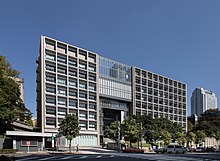




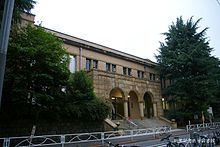

Faculties
Keio has ten undergraduate faculties, which cover a wide range of academic fields, with each operating independently and offering broad educational and research activities. The faculties, with a planned annual number of enrolled first-year students in parentheses, are:
- Faculty of Letters (800)
- Faculty of Economics (1200)
- Faculty of Law (1200)
- Faculty of Business and Commerce (1000)
- School of Medicine (112)
- Faculty of Science and Technology (932)
- Faculty of Policy Management (425)
- Faculty of Environment and Information Studies (425)
- Faculty of Nursing and Medical Care (100)
- Faculty of Pharmacy (210)
Graduate schools
In addition to the ten undergraduate faculties listed above, Keio has fourteen graduate schools. Many professors are associated with both an undergraduate faculty and a graduate school.
- Graduate School of Letters
- Graduate School of Economics
- Graduate School of Law
- Graduate School of Human Relations
- Graduate School of Business and Commerce
- Graduate School of Medicine
- Graduate School of Science and Technology
- Graduate School of Business Administration
- Graduate School of Media and Governance
- Graduate School of Health Management
- Graduate School of Pharmaceutical Sciences
- Law School
- Graduate School of Media Design
- Graduate School of System Design and Management
Media centers
Keio's Media Centers, with combined holdings of over 4.58 million books and publications, are one of the largest academic information storehouses in the country.[104]
- Mita Media Center
- Hiyoshi Media Center
- Media Center for Science and Technology
- Shinanomachi Media Center
- SFC Media Center
Information technology centers
- ITC Headquarters
- Mita ITC
- Hiyoshi ITC
- Shinanomachi ITC
- Science & Technology ITC
- Shonan Fujisawa ITC
Affiliated schools
- Keio Yochisha Elementary School
- Keio Yokohama Elementary School
- Keio Futsubu School (Boys Junior High School)
- Keio Chutobu Junior High School
- Keio Shonan Fujisawa Junior and Senior High School
- Keio Senior High School
- Keio Shiki Senior High School
- Keio Girls Senior High School
- Keio Academy of New York (High School)
Language education
- Japanese Language Program
- Keio Foreign Language School
Others
- Keio Marunouchi City Campus (KMCC)
Hospital
Keio University Hospital is one of the largest and most well-known general hospitals in Japan,[citation needed] the number of surgeries for carcinoma uteri in 2007 was top and the one for lung cancer was third among all university hospitals.[105] and is also a famous teaching hospital. The number of trainee doctors who selected Keio as their first choice training hospital was 30 (33rd) among all Japanese teaching hospitals in 2010.[106] Established in 1920, it has over 1,000 beds, a leading laboratory, and research and medical information divisions.[11]
- Keio University Hospital (慶應義塾大学病院 or 慶應大学病院)
Campuses
There are eleven campuses.
- Mita Campus (2-15-45 Mita, Minato, Tokyo)
- Hiyoshi Campus (4-1-1 Hiyoshi, Kohoku, Yokohama, Kanagawa), home of the Hiyoshi tunnels
- Yagami Campus (3-14-1 Hiyoshi, Kohoku, Yokohama, Kanagawa)
- Shinanomachi Campus (35 Shinanomachi, Shinjuku, Tokyo)
- Shonan Fujisawa Campus (Fujisawa, Kanagawa, aka SFC) designed by Fumihiko Maki
- Shiba Kyoritsu Campus (Minato ward, Tokyo)
- Shin-Kawasaki Town Campus (Kawasaki, Kanagawa)
- Tsuruoka Town Campus of Keio (Tsuruoka, Yamagata, aka TTCK)
- Urawa Kyoritsu Campus (Urawa, Saitama)
- Keio Osaka Riverside Campus (Osaka)
- Keio Marunouchi City Campus (Tokyo)
Notable alumni
Some of the prominent Keio alumni include Japanese Prime Ministers Junichiro Koizumi (2001–2006), Ryutaro Hashimoto (1996–1998), and Tsuyoshi Inukai (1931–1932). Dozens of other alumni have been cabinet members and governors in the post-war period.[107] Its alumni include 230 CEOs of major companies and 97 CEOs of foreign-affiliated companies (both highest in Japan).[11] Keio has over 320,000 alumni in 866 alumni associations.[11][108]
Politicians



- Junichiro Koizumi, the 87th/88th/89th Prime Minister of Japan (2001–2006), the 20th President of Liberal Democratic Party of Japan (Economics, 1967)
- Ryutaro Hashimoto, the 82nd/83rd Prime Minister of Japan (1996–1998), the 17th President of Liberal Democratic Party of Japan (Law, 1960)
- Tsuyoshi Inukai, the 29th Prime Minister of Japan (1931–1932), the 6th President of Rikken Seiyūkai
- Ichirō Ozawa, Former President of Democratic Party of Japan, Former Secretary General of Liberal Democratic Party of Japan (Economics, 1967)
- Tamisuke Watanuki, President of People's New Party, Former Speaker of The House of Representatives of Japan (Economics, 1950)
- Toshiko Hamayotsu, Minister for Global Environmental Issues and Director-General of Environment Agency of Government of Japan (1994).[109]
- Kenji Kosaka, Minister of Education, Culture, Sports, Science and Technology (Law, 1968)
- Jirō Kawasaki, Minister of Health, Labour and Welfare (Business and Commerce, 1971)
- Andrew Thomson, Minister for Sport and Tourism and Minister Assisting the Prime Minister for the Sydney 2000 Games in the Australian Government 1997 – 1998
- Shigefumi Matsuzawa, Governor of Kanagawa (Law, 1982)
- Akihiko Noro, Governor of Mie (Science and Technology, 1969)
- Genjirō Kaneko, Minister of Agriculture, Forestry and Fisheries (2021-2022), Governor of Nagasaki (Letters, 1968)
- Motohiro Ōno, Governor of Saitama (Law, 1987)
- Hiroshi Nakai, Chairman of the National Commission on Public Safety, Minister of State for Disaster Management and the Abduction Issue (Economics, 1969)
- Yūzan Fujita, Governor of Hiroshima (Business and Commerce, 1972)
- Ryōzō Hiranuma, Mayor of Yokohama, Order of Culture
- Keiichi Inamine, Governor of Okinawa (Economics, 1957)
- Masaharu Ikuta, President of Japan Post, Former CEO of Mitsui O.S.K. Lines (Economics, 1957)
- Yukio Ozaki, Mayor of Tokyo, Minister of Justice, Education, "Father of parliamentary politics" in Japan.[110]
- Nobuteru Ishihara, Minister of Land, Infrastructure and Transport, Minister of State for Administrative and Regulatory Reform, Candidate for the LDP presidency 2008
- Heitaro Inagaki, Minister of Economy, Trade and Industry (Economics, 1913)
- Banri Kaieda, Minister of Economy, Trade and Industry (Law)
- Hirofumi Nakasone, Minister for Foreign Affairs
- Yoshio Sakurauchi, Minister for Foreign Affairs
- Kamata Eikichi, Minister of Education[111]
- Hidenao Nakagawa, Chief Cabinet Secretary
- Mitsuo Horiuchi, Minister of International Trade and Industry
- Yoshiyuki Kamei, Minister of Agriculture, Forestry and Fisheries
- Seiichi Ota, Minister of Agriculture, Forestry and Fisheries
- Ryu Shionoya, Minister of Education, Science and Technology
- Kosuke Hori, Minister of Education
- Fusanosuke Kuhara, Minister of communications
- Shigeru Ishiba, Minister of Defense, Minister of Agriculture, Forestry and Fisheries (Law, 1979)
- Kazuyoshi Kaneko, Minister of Land, Infrastructure, Transport and Tourism and Minister for Ocean Policy
- Takeo Kawamura, Minister of Education, Science and Technology and Chief Cabinet Secretary
- Koichi Yamamoto, Minister of Environment
- Akira Amari, Minister of Economy, Trade and Industry and Minister of State in charge of Administrative Reform
- Tatsuya Ito, Minister of State for Financial Services
- Tadamori Oshima, Minister of Agriculture
- Takeo Hiranuma, Minister of Transport and Minister of Economy, Trade, and Industry
- Akira Nagatsuma, Minister of Health, Labour and Welfare, Minister of State for Pension Reform
- Masajuro Shiokawa, Chief Cabinet Secretary of Japan
- Heizō Takenaka, Minister of Internal Affairs and Communications (Emeritus Prof.)
- Wataru Takeshita, Minister for Reconstruction
- Jon Richards, Wisconsin legislator
- Sommai Hoontakoon, Minister of Finance (Thailand) (Economics, 1942)[112]
- Set Aung – politician, economist and management consultant, incumbent Deputy Planning and Finance Minister of Myanmar
- Yun Duk-min –ambassador of South Korea to Japan
Public servants, international organizations
- Takeshi Kasai, WHO Regional Director of Western Pacific (medicine, 1990)[113][114]
- Shigeru Omi, WHO Regional Director of Western Pacific,[113][114]
- Kiyoko Okabe, the first female justice of the Supreme Court of Japan (Master, Law, 1974)[115]
- Taro Takemi, president of the World Medical Association and Japan Medical Association (MD, medicine, 1930)
- Ichirō Fujisaki, diplomat, Chairman of Executive Committee of United Nations High Commissioner for Refugees (Economics (dropout), 1969)
Central Bank Governors
- Shigeaki Ikeda, Minister of Finance, Commerce and Industry, Governor of The Bank of Japan
- Makoto Usami, Governor of The Bank of Japan
- Tarisa Watanagase (Thai), Governor of the Bank of Thailand, 2006–2010 (Economics)
- Chang Kia-ngau (Economics, 1906–1908), Governor of the Central Bank of Republic of China[116]
Astronauts
- Chiaki Mukai, JAXA astronaut (MD, medicine, 1988)
- Akihiko Hoshide, JAXA astronaut
Finance
- Taizo Nishimuro, Chairman and CEO of Tokyo Stock Exchange, Former CEO of Toshiba Corporation (Economics 1961)
- Koichiro Miyahara, Chairman and CEO of Tokyo Stock Exchange[117]
- Atsushi Saito, Chairman and CEO of Tokyo Stock Exchange,[117]
- Shigeharu Suzuki, President and CEO of Daiwa Securities Group (Economics 1971)
Media
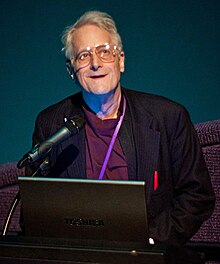
- Tōru Shōriki, owner of The Yomiuri Shimbun (Economics, 1942)
- Tarō Kimura, journalist (Law, 1964)
- Akira Ikegami, journalist (Economics, 1973)
- Kazuhiko Torishima, president of Hakusensha (Law, 1976)
- Motoaki Tanigo, CEO of Hololive Production (Science and Technology)
Other business people
- Akio Toyoda, President and CEO Toyota Motor Corporation 2009–current
- Yutaka Katayama, the first president of the U.S. operations of Nissan Motors (Economics 1935)
- Osamu Nagayama, CEO of Chugai Pharmaceutical and Chairman of Sony Corporation
- Katsuaki Watanabe, President of Toyota Motor Corporation (Economics 1964).[118]
- Yuzaburo Mogi, Chairman and CEO of Kikkoman Corporation (Law 1958)
- Yotaro Kobayashi (Economics, 1956), chairman of Fuji Xerox, former chairman of Japan Association of Corporate Executives[119]
- Shinzo Maeda, President and CEO of Shiseido (Letters 1970)
- Hidetaka Miyazaki, President of FromSoftware, game designer and director[120]
- Ichizō Kobayashi, Founder of Hankyu Railway and the Takarazuka Revue, Minister of Commerce and Industry in the 1940 Konoe Cabinet
- Nobutada Saji, Chief executive of Suntory Ltd., the wealthiest individual in Japan as of 2004 by Forbes
- Akira Mori, President and CEO of Mori Trust, the fourth-wealthiest person in Japan as of 2013 by Forbes
- Keiichi Ishizaka, chairman and CEO, Warner Music Japan Inc. (Business and Commerce, 1968) – 2009 Medal of Honor Awardee
- Lee Jae-yong, vice chairman of Samsung Electronics (MBA 1995)
- Teruaki Yamagishi, received the 4th Class, Order of the Rising Sun Gold Rays with Rosette in 2008
- Takeo Shiina, Chairman of IBM Japan, former Chairman of Japan Association of Corporate Executives (Science and Technology 1951)
- Matsuo Yokoyama, former president of Walt Disney Enterprises of Japan
Academia
Dozens of alumni and professors have been elected as academy members or in important positions.[121]
- Shinzo Koizumi (politics, 1910), Member of Japan Academy, best known as the educator of His Majesty the Emperor Emeritus at the age of the prince. Received an honorary doctorate from Columbia University[122][123]
- Sho-Chieh Tsiang (undergraduate atten.), member of Academia Sinica[124]
- Atsuo Iiyoshi (engineering, 1960), emeritus professor of Kyoto University, an honorary doctorate of Russian Academy of Sciences[125]
- Seiichiro Takahashi (politics, 1908), Member of Japan Academy, Minister of Education
- Toshihiko Izutsu (literature, 1937), Member of Japan Academy
- Akira Hayami (economics, 1954), Member of Japan Academy, coined the notion of "Industrious Revolution"[126][127]
- Tokuzo Fukuda (prof.), Member of Japan Academy[128]
- Kazui Tashiro (Ph.D. in economics), Member of Japan Academy,[121]
- Junzaburo Nishiwaki (economics, 1917), nominated for Nobel Prize, International Honorary Member of American Academy of Arts and Sciences[129]
- Tsuneo Tomita (medicine, 1932), International Honorary Member of American Academy of Arts and Sciences, Member of Japan Academy, Professor Emeritus of Yale University[130][131][132]
- Osamu Saito (Hitotsubashi University) (economics, 1968), member of Japan Academy, International Honorary Member of American Academy of Arts and Sciences, Professor Emeritus of Hitotsubashi University[133][134][135]
- David J. Farber, fellow, American Association for the Advancement of Science (the Distinguished Professor and Co-Director of Cyber Civilization Research Center)[136]
- Hiromoto Watanabe (1865), the first President of Tokyo Imperial University[137]
- Hamao Arata (1869), the third and eighth President of the Tokyo Imperial University[137]
- Sahachiro Hata (Prof.), nominated for Nobel Prize,[138] member of Japan Academy,[139]
- Masayuki Amagai (medicine, 1985), International Member of National Academy of Medicine[140]
- Masaharu Tsuchiya (medicine, 1953), member of Académie Nationale de Médecine,[141]
- Masaki Kitajima (medicine, 1966), Honorary Fellow of Royal College of Surgeons of England, member of European Academy of Science[142]
- Ken Sakamura (engineering, 1974), emeritus professor of University of Tokyo, Japan Academy Prize (academics), the creator of the real-time operating system architecture TRON project[143]
- Takao Suzuki (sociolinguist) (literature, 1950), former professor of Yale University[144]
- Toshio Ito (Medicine), best known for the discovery of Ito cell, Japan Academy Prize (academics),[145][146]
- Hideyuki Okano (medicine, 1983), the first in the world to produce transgenic marmosets (Callithrix jacchus) with germline transmission.[147] Besides, he is to conduct the world's first clinical test in which artificially derived stem cells will be used to treat patients with spinal cord injuries.[148]
- Toju Hata (medicine, 1934), Japan Academy Prize (academics), best known for the discovery of Mitomycin C,[149][150]
- Yoshitaka Tanimura, derived Hierarchical equations of motion with Ryogo Kubo, Professor of Kyoto University, Humboldt Prize Winner (Sci.and Tech)[151]
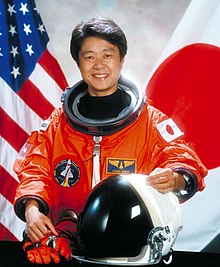
- Katsuhiko Mikoshiba (medicine, 1969), Emeritus Professor of The University of Tokyo, first cloned in the world of the IP3 receptor in the laboratory, which was found to play an important role in many biological functions such as body development and brain plasticity. Legion of Honor, honorary doctorate from Karolinska Institute (2011),[152] Japan Academy Prize (academics)[153]
- Kuniaki Tatsuta (PhD, 1969), the first in the world to synthesize totally four big Antibiotics (aminoglycoside, -lactam, macrolide and tetracycline antibiotics), which was accomplished by using carbohydrates as chiral sources in their laboratories. Japan Academy Prize (academics),[154][155]Ernest Guenther Award(2013)[156]
- Hikohjiro Kaneko (Ph.D. in Literature, 1946), Japan Academy Prize (academics)[157]
- Tatsuya Sakamoto (Economics, 1979), Japan Academy Prize (academics)[158]
- Masayoshi Tomizuka, professor in Control Theory in the Department of Mechanical Engineering, and director of Mechanical Systems Control Laboratory, University of California, Berkeley. He holds the Cheryl and John Neerhout, Jr., Distinguished Professorship Chair, and has supervised more than 90 PhD students to completion, many of which have become professors in universities in the USA, Taiwan, etc., prestigious for the research in the field of Mechanical Engineering. (B.S. and M.S. degrees, Mechanical Engineering, 1968 and 1970)
- Yoshio Nishi (B.A. , 1966), Charles Stark Draper Prize (2014) Laureate.[159]
- Shosuke Okamoto (medicine, 1941), first synthesized in 1962 Tranexamic acid with Utako Okamoto. Emeritus professor of Kobe University[160]
- Tatsuji Nomura (medicine, 1945), a pioneer in the development of laboratory animals with the aim of assuring the reproducibility of experimental results in medical research. Medal of Honor With Purple Ribbon from Japanese Government(1984).[161]
- Fumiko Yonezawa (Emeritus), The first female President of The Physical Society of Japan,[162] the Laureate of L'Oréal-UNESCO For Women in Science Awards in 2005.
- Yasuhiro Matsuda, professor of international politics at the University of Tokyo (Law)
- Yoshihiro Tsurumi, professor of international business at Baruch College of the City University of New York (Economics)
- Jun Murai, "The Father of The Internet" in Japan, Legion of Honor (2018) (PhD, Engineering)[163]
- Yasuhiro Koike, Developed the High-bandwidth graded-index plastic optical fibre.[164]
He is thought as one of the Nobel Prize candidates in Physics in terms of the achievement of plastic optical fibre. (Sci. and Tech)[165][166] - Masaru Tomita, Established the metabolomics analysis by using the CE-MS. (Environment and Information Studies)
- Eitaro Noro, Marxian Economist. The Author of "History of the Development of Japanese Capitalism"(1930) (Native:「日本資本主義発達史講座」), Iwanami Shoten, Tokyo[167]
- Yuichi Motai, professor of electrical and computer engineering at Virginia Commonwealth University, NSF Career Award (2011)
- Joi Ito, former director of the MIT Media Lab, professor at Massachusetts Institute of Technology and Harvard University (PhD, Media and Governance, 2018)
Art
- Shotaro Yasuoka, Member of Japan Art Academy
- Yamamoto Kenkichi, Member of Japan Art Academy
- Hiroshi Sakagami, Member of Japan Art Academy
- Shusaku Endo (Literature, 1948) Akutagawa Prize, Order of Culture, honorary doctorate from Georgetown University[168]
- Daigaku Horiguchi, Poet, Translator, Member of Japan Art Academy
- Tanaka Chikao, Member of Japan Art Academy (Literature)
- Rofū Miki (undergraduate attendee), poet[169]
- Gozo Yoshimasu, Member of Japan Art Academy
- Jun Etō, Member of Japan Art Academy, literary critic
- Mantaro Kubota, Member of Japan Art Academy
- Haruo Sato, Member of Japan Art Academy (Literature)
- Kafū Nagai, Member of Japan Art Academy, Order of Culture (Prof.)
- Shinobu Orikuchi, Ethnologist (Emeritus prof.)
- Takitaro Minakami, author (Economics)
- Yojiro Ishizaka, author (Literature)
- Sakutarō Hagiwara, Poet
- Yumeno Kyūsaku, Surrealistic detective novelist
- Kazuki Kaneshiro, Zainichi Korean novelist
- Kôhei Tsuka, playwright, theatre director, and screenwriter
- Adebayo Adewusi, Lawyer and Public Administrator.
- Yoshio Taniguchi (Engineering, 1960), member of Japan Art Academy. Architect best known for his redesign of the Museum of Modern Art in New York City which was reopened on November 20, 2004, [170]
- Fumihiko Maki (Keio High school, undergraduate attend.), International Honorary Member of American Academy of Arts and Sciences, Wolf Prize in Arts,[171][172][173]
- Kyoko Matsuoka, author and translator of children's literature
Others
- Ryuichi Kuki, Envoy Extraordinary and Minister Plenipotentiary, Governor of The Imperial Museum (The Tokyo National Museum, Kyoto National Museum, and Nara National Museum), The Father of Syuzo Kuki (1874)
- Theodor Holm "Ted" Nelson, Computer architect, visionary, and contrarian (PhD, Media and Governance, 2002)
- Wataru Kamimura, professional shogi player (the first university graduate to become a shogi professional) (Science and Technology / mathematical sciences, 2013)
- Yūka Nishio, voice actress and musician[174]
- Ghib Ojisan, a travel YouTuber based in Singapore[175]
- Sho Sakurai, singer, actor, entertainer, newscaster, member of Arashi, first artist in Johnny & Associates to graduate from University. (Bachelor of Economics, 2004)[176][177][178][179]
Notable faculty
- Fukuzawa Yukichi, founder of Keio University, the current portrait of 10,000-yen banknote
- Kohei Itoh, successfully generated and detected quantum entanglement between electron spin and nuclear spin in phosphorus impurities added to silicon with Dr. John Morton at Oxford University. This is the world's first successful generation. Also an alumni.[180]
- Genichi Kato, nominated for Nobel Prize, member of Japan Academy[138]
- Kitasato Shibasaburō, first dean of Keio University School of Medicine; member of Japan Academy, a fellow of Royal Society of London,[181] nominated for Nobel Prize[138]
- Ryogo Kubo, the Boltzmann Medal, Order of Culture, member of Japan Academy, International Honorary Member of American Academy of Arts and Sciences[182][183][184]
- Mikinosuke Miyajima, International Honorary Member of American Academy of Arts and Sciences, Japan's representative for League of Nations Health Organization.[185]
- Yone Noguchi, poet; also alumni[186]
- Shuichi Nosé, famous for the Nosé–Hoover thermostat[187]
- Keisuke Suzuki, member of Japan Academy[188]
- Toshiyuki Takamiya, professor emeritus; led the digital documentation, facsimile reproduction, and distribution of many rare medieval books and manuscripts including the Gutenberg Bible and Chaucer's Canterbury Tales.
Bibliography
- The Keiogijuku University: a brief account of its history, aims and equipment. Keio Gijuku University. 1912.
Notes
References
See also
- Keio Medical Science Prize
- Keio Media Centers (Libraries)
- Eliica
- Auto-ID Labs
- Keio University Shonan Fujisawa Campus
- Keio Shonan-Fujisawa Junior & Senior High School
- Sakura Tsushin ("Sakura Diaries"), a manga and anime series by U-Jin which prominently features Keio University.
- List of National Treasures of Japan (crafts: others)
External links
